By Thomas Shugart and Javier Gonzalez
You may have heard that China’s military has developed a “carrier-killer” ballistic missile to threaten one of America’s premier power-projection tools, its unmatched fleet of aircraft carriers.1 Or perhaps you have read about China’s deployment of its own aircraft carrier to the Taiwan Strait and South China Sea. But heavily defended moving targets like aircraft carriers would be a challenge to hit in open ocean, and were China’s own aircraft carrier (or even two or three like it) to venture into open water in anger, the U.S. submarine force likely would make short work of it.2 In reality, the greatest military threat to U.S. vital interests in Asia may be one that has received somewhat less attention: the growing capability of China’s missile forces to threaten U.S. bases in the region.
In a time of rising geopolitical tension in Asia, U.S. leaders and policymakers should understand that in the event of an unforeseen U.S.-China crisis, especially one that appears to threaten China’s claimed core strategic interests or the legitimacy of the Chinese Communist Party, a preemptive missile strike against the forward bases that underpin U.S. military power in the Western Pacific could be a real possibility. This might be the case particularly if China perceives that its attempts at deterrence of a major U.S. intervention – say in a cross-strait Taiwan crisis or in a brewing dispute over the Senkaku Islands – have failed.3 Driven partly by distinct first-mover advantages associated with the employment of modern long range precision weaponry, such a preemptive strike appears consistent with available information about China’s missile force doctrine and military strategy, and satellite imagery shown below points to what may be real-world Chinese efforts to practice its execution.
But does China have the missile forces necessary to execute a preemptive missile strike, and would it work against U.S. and allied missile defenses in Asia? We conducted an analysis to attempt to answer these questions. The results of our modeling and simulation, which show the potential for devastation of U.S. power projection forces and bases in Asia, are deeply concerning – and a call for action.
The People’s Liberation Army Rocket Force: Precision Strike with Chinese Characteristics
Officially founded in 1966 as the PLA Second Artillery Corps (SAC), China’s ballistic missile force originally was focused primarily on nuclear deterrence.4 Informed by China’s analysis of the startling success of U.S. precision strike cruise missiles against Iraqi forces during the 1990–91 Gulf War, the force transformed from a strictly nuclear strategic force to one with both nuclear and conventional ballistic missiles, through a strategy of “Dual Deterrence and Dual operations.”5 Adopting what was described in 2013 by Ian Easton of Project 2049 as a “projectile-centric strategy,” this has resulted in China focusing on the delivery of precision strike munitions via individual projectiles (such as cruise and ballistic missiles) rather than the platform-based strike forces (such as aircraft, ships, and submarines) that are the hallmark of U.S. power projection.6 This strategy minimizes China’s disadvantages in platform capabilities, and takes advantage of asymmetric factors such as theater geography (U.S. and allied lack of strategic depth in Asia), financial asymmetries (low costs of Chinese munitions production), and gaps in international law (China’s nonparticipation in the U.S.-Russia Intermediate Nuclear Forces Treaty).7The PLA Rocket Forces recognized early on that this new approach would be fundamental during what China refers to as a “local war under modern, high-technology conditions,” and that it would require an improvement in both the quality and the quantity of their missiles.8 Growing in size throughout this transformation, the Chinese missile force now consists of about 100,000 personnel9 – by comparison roughly ten times that of the U.S.’s primary ballistic missile force, the U.S. 20th Air Force.10 And in 2015, what had been the Second Artillery Corps was elevated to a status coequal to that of China’s other military services and officially renamed as the PLA Rocket Force.11
In terms of specific missions, Michael S. Chase of the U.S. Naval War College wrote in 2014 that PLA Rocket Force doctrine calls for a range of deterrence, compellence, and coercive operations. In the event that deterrence fails, the missions of a conventional missile strike campaign could include “launching firepower strikes against important targets in the enemy’s campaign and strategic deep areas.”12 Potential targets of such strikes would include command centers, communications hubs, radar stations, guided missile positions, air force and naval facilities, transport and logistical facilities, fuel depots, electrical power centers, and aircraft carrier strike groups.
Chase also stated that “In all, Chinese military writings on conventional missile campaigns stress the importance of surprise and suggest a preference for preemptive strikes.” And while most Sinologists discount the idea of a true bolt-from-the-blue attack in a crisis without first giving an adversary a chance to back down, preemptive missile strikes to initiate active hostilities could be consistent with China’s claimed overall military strategy of “active defense.”13 As a 2007 RAND study of China’s anti-access strategies outlined, “This paradox is explained by defining the enemy’s first strike as ‘any military activities conducted by the enemy aimed at breaking up China territorially and violating its sovereignty’ . . . and thereby rendered the equivalent of a ‘strategic first shot.’”14 China analyst Dean Cheng stated similarly in 2015, “From Mao to now, the concept of the active defense has emphasized assuming the strategic defensive, while securing the operational and tactical initiative, including preemptive actions at those levels if necessary.”15 Thus, China could consider a preemptive missile strike to be a defensive “counterattack” to an adversary’s threatening of China’s sovereignty (e.g., claims to Taiwan or the South China Sea) solely in the political or strategic realm.
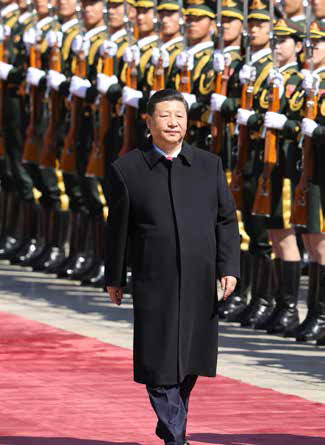 Chinese President Xi Jinping views a guard of honor during a welcoming ceremony outside China’s Great Hall of the People in Beijing.
Chinese President Xi Jinping views a guard of honor during a welcoming ceremony outside China’s Great Hall of the People in Beijing.
In some ways, the PLA Rocket Force’s doctrine may parallel what Western analysts have learned about Cold War–era Soviet plans to deal with NATO’s maritime forces. Soviet doctrine took a holistic view of anti-carrier and antisubmarine warfare, with an emphasis on coordinated action against both enemy operating forces and the logistical and command centers that support them. In a nuclear conflict, Soviet doctrine emphasized the use of nuclear cruise and ballistic missiles to strike ships in port along with other key installations.16 But by the end of the Cold War, Soviet analysts considered that modern high accuracy conventional weapons had become “comparable in combat effectiveness with low-yield tactical nuclear weapons.”17 An examination of a 1975 RAND corporation study of low-yield nuclear weapon effects seems to confirm this idea: When weapon accuracy is improved to a few meters (or tens of feet), the estimated likelihood of destruction for some “soft” targets by conventional weapons (perhaps equivalent to a .001kT warhead) appears roughly equivalent to the effects of typical tactical nuclear weapons, which were likely to miss their targets by several hundred feet.18 By marrying great accuracy with numerous ballistic missiles, China may have developed a capability that the Soviet armed forces never had: the ability to strike effectively, in a matter of minutes, U.S. and allied bases, logistical facilities, and command centers without resorting to the use of nuclear weapons, and without having established air superiority. As Ian Easton stated in 2013,
The Chinese military may achieve strategic effects that until recently were only achievable through the use of nuclear weapons . . . during the Cold War, both NATO and Warsaw Pact forces tasked nuclear missile units with the mission of destroying the other’s key air bases. The PLA plans to achieve the same effect with a relatively small number of ballistic missiles armed with conventional runway penetrating submunitions.19
As a side note, China’s cyber doctrine also stresses that “striking first and striking hard” is essential, with a similar focus on preemptive strikes and offensive dominance.20 Given China’s mutual vulnerability to cyber disruption of command and control networks, notably those of the somewhat dispersed PLA Rocket Force, the dynamics of the new cyber domain of military operations may work additively with the other first-mover advantages associated with precision kinetic strikes. This could further drive Chinese decisionmaking toward preemptive strikes, both kinetic and non-kinetic, in the event of a crisis.
Figure 1
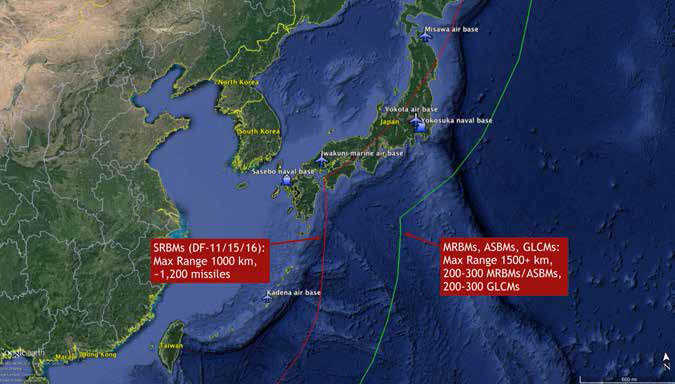
PLA Rocket Force missile ranges vs. U.S. bases in Asia.
Coming of Age
According to the U.S. Department of Defense’s recently- released annual report to Congress on the Chinese military, China currently fields about 1,200 conventionally armed short-range ballistic missiles (SRBMs, 300-1000 km range), 200 to 300 conventional medium- range ballistic missiles (MRBMs, 1000 to 3000 km), an indeterminate number of conventional intermediate- range ballistic missiles (IRBMs, 3000-5,500 km), and 200-300 ground launched cruise missiles (GLCMs, 1500+ km). A 2015 RAND study provided 2017 inventory estimates of similar scale, and also estimated that improvements in the accuracy of China’s ballistic missiles may allow them to strike fixed targets in a matter of minutes with an accuracy of a few meters. RAND assessed that key U.S. facilities throughout Japan already could be within range of thousands of difficult-to-defeat advanced ballistic and cruise missiles (see Figure 1).21
And in recent years, the PLA Rocket Force appears to have been making real the specific targeting capabilities necessary to support execution of the preemptive strike discussed above. As examples, a 2009 RAND study of open-source literature suggested that flechette submunitions likely would be used against missile launchers, parked aircraft, fuel tanks, vehicles, air defense weapons, and ships in port.22 Penetrating munitions would be used against airfield runways, aircraft shelters, and semi-underground fuel tanks.23 In terms of sequencing, the study suggested that an initial wave of ballistic missiles would neutralize air defenses and command centers and crater the runways of military air bases, trapping aircraft on the ground. These initial paralyzing ballistic missile salvos could then be followed by waves of cruise missiles and aircraft targeting hardened aircraft shelters, aircraft parked in the open, and fuel handling and maintenance facilities.
Figure 2
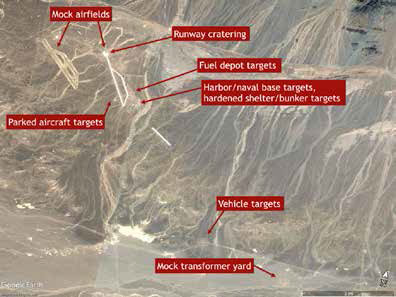
Possible PLA Rocket Force ballistic missile impact range in Western China.
These capabilities already may have been tested at a ballistic missile impact test site (see Figure 2) located on the edge of the Gobi Desert in western China.24 Commercial satellite images seem to show a range of test targets representing just the sort of objectives discussed in the doctrine above, including groups of vehicles (perhaps representing mobile air and missile defense batteries – see Figure 3), aircraft targets parked in the open (Figure 4), fuel depots (Figure 5), runway cratering submunition tests (Figure 6), electrical power facilities (Figure 7), and the delivery of penetrating munitions to hardened shelters and bunkers (Figure 8) and command centers (Figure 9). Of note, the 2007 RAND study mentioned above stated that submunitions are generally not capable of penetrating the hardened shelters used to house fighter aircraft at many air bases, that China’s ballistic missiles lack the accuracy to ensure a high percentage of direct hits using unitary warheads, and thus, “fighter aircraft in hardened shelters would be relatively safe from Chinese ballistic missile attack.” This clearly appears no longer to be the case, and the demonstrated ability to precisely deliver penetrating warheads to facilities such as command centers in a matter of minutes also could provide a key capability to destroy them, with their command staffs, in the initial waves of an attack.
China has not been shy about displaying the advancing capabilities of the PLA Rocket Force. Beijing openly displayed some of its latest missiles (such as the DF-26 “Guam-killer” missile25) in its 70th anniversary parade in 2015 and painted the missiles’ identification on their sides in Western characters, in case anyone missed the point.26 The PLA Rocket Force also put out a recruiting music video and other TV footage showing the employment of multiple coordinated missile launches, as well as the use of submunitions.27
Figure 3
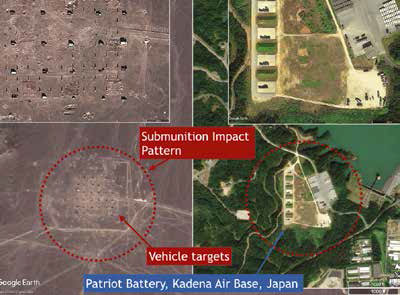
Left side – Possible vehicle targets with submunition impact pattern, imagery dated December 2013. Right side – U.S. Patriot air and missile defense battery, Kadena Air Base, Okinawa, Japan. Scale of submunition pattern overlaid for comparison.
Figure 4

Possible parked aircraft target, imagery dated August 2013. Upper left – aircraft shaped target, imagery dated May 2012. Lower right – F-22 fighter parking area, Kadena Air Base, Okinawa, Japan.
Figure 5
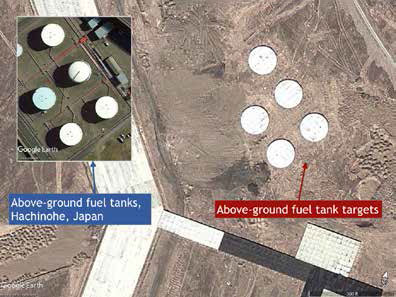
Possible test targets simulating above-ground fuel tanks, imagery dated September 2012. Compared with actual fuel tanks in Japan, similar scale.
Figure 6
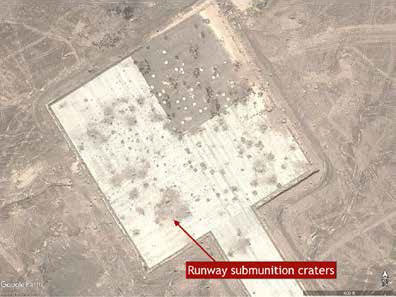
Possible runway cratering munition testing, imagery dated September 2012.
Figure 7
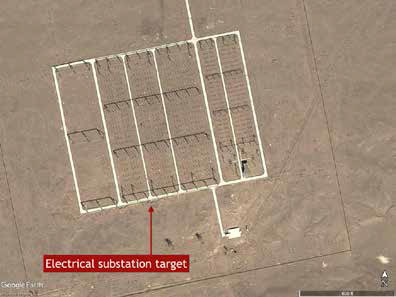
Possible mock electronic substation target, imagery dated July 2013. Note no electrical lines running to or from the target in its very remote location. While no craters are visible, disablement may be planned using other methods, such as dispersal of conductive graphite filaments.
Figure 8
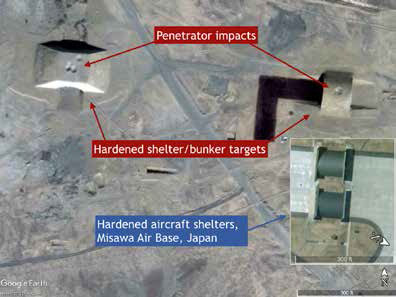
Possible hardened aircraft shelter or bunker test targets, imagery dated October 2016. Penetrator submunition impacts visible. Lower right – Misawa Air Base, Japan, similar scale.
Figure 9
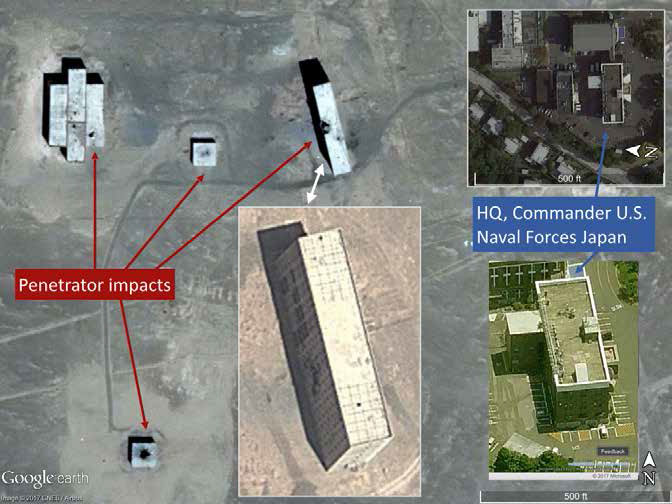
Possible test targets simulating command center buildings, imagery dated May 2012 (undamaged) and May 2016 (showing impact points). Right hand side – U.S. Naval Forces Japan headquarters, Yokosuka, Japan; similar scale.
Pearl Harbor 2.0?
In 2010, Toshi Yoshihara of the U.S. Naval War College wrote that authoritative PLA publications indicated China’s missile forces might attempt a preemptive strike to knock out the U.S. Navy in Asia by specifically targeting vulnerable carriers and warships in port.28 Yoshihara noted in particular that “Perhaps no other place captures the Chinese imagination as much as Yokosuka,” the major U.S. naval base near Tokyo, home to the U.S. Navy’s sole permanently forward-deployed aircraft carrier, the USS Ronald Reagan (CVN-76), as well as other ships and vital support facilities (see Figure 10). In 2012, Dr. Yoshihara again stated:
[T]he Imperial Japanese Navy’s surprise attack on Pearl Harbor remains a popular, if somewhat tired, metaphor for the dangers of unpreparedness and overexposure to risk . . . But the real possibility that U.S. bases in the Western Pacific could once again be vulnerable . . . has occasioned little publicity or debate.29
Evidence that China may have been practicing to strike ships in port with ballistic missiles would lend credence to Yoshihara’s concerns. And such evidence exists: Images taken in 2013 (see Figure 11) seem to show China testing its ability to do so.
Specifically, the PLA Rocket Force appears to have been practicing on several ship targets of a similar size to U.S. Arleigh Burke–class destroyers moored in a mock port that is a near-mirror image of the actual inner harbor at the U.S. naval base in Yokosuka (see Figure 12). Note what looks like an impact crater located near the center of the three ship targets, close enough to have potentially damaged all three ships with submunitions. The display of these targets may itself constitute signaling to the United States and its allies as a long-term deterrent effort. All the same, it bears considering that the only way that China could realistically expect to catch multiple U.S. ships in port as shown above would be through a surprise attack. Otherwise, with clear signs of imminent hostilities, the United States likely would have already sent its fleet to sea. Some skeptics might say that catching the U.S. flat-footed would be unlikely, but history teaches us not to discount the possibility of successful surprise attacks.
Figure 10
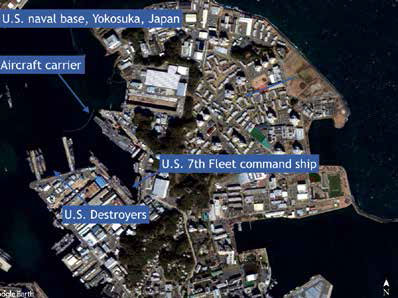
Home of U.S. 7th Fleet, Yokosuka, Japan.
Figure 11
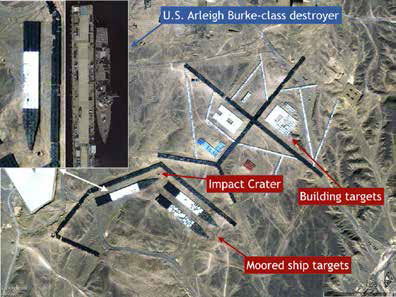
Possible moored ship and naval facility targets, imagery dated August 2013. Compared for scale with actual U.S. destroyer.
Figure 12
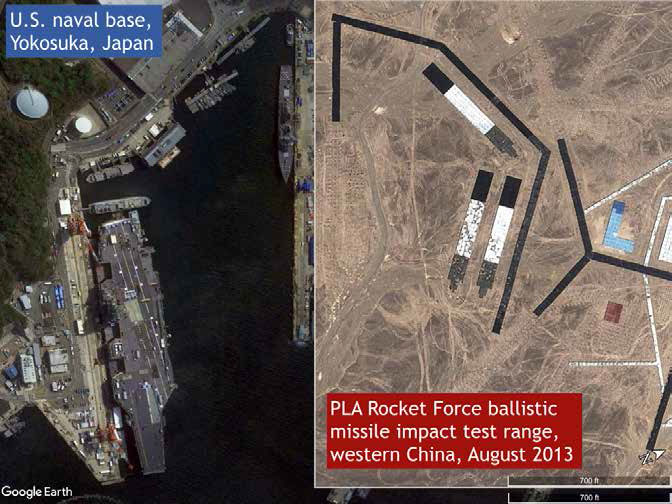
Possible naval ship and harbor targets, compared with inner harbor at U.S. naval base at Yokosuka, Japan.
The Realm of the Possible? Operational Analysis of a Preemptive Missile Strike
Given that the China’s missile force appears to have developed the capability to precisely target U.S. fixed bases, infrastructure, and command centers, and seems to have been practicing doing so preemptively, a key question is whether China has the capacity to carry out an effective preemptive missile strike.
The methodology we used to try to answer this question consisted of a few basic steps. First, we took the categories of targets mentioned above in PLA Rocket Force doctrine, and through an open-source “red team” effort attempted to ascertain just what specific U.S./allied forces and facilities would likely be targeted. Then we assessed how many missiles, and of what types, might be required to strike that notional target set. Given the estimated numbers and types of missiles required, we compared those with other analysts’ open-source estimates of PLA Rocket Force inventories and orders of battle to determine whether such a strike would be feasible. Finally, using two different methods, we simulated how a notional missile strike might fare in a surprise attack against what is our best guess of the current state of U.S. and allied missile defenses. We also attempted to determine what sort of damage the resulting strike might inflict on its targets.
Launch vehicles for DF-26 intermediate-range ballistic missiles, known informally as “the Guam-Killer,” are displayed in a military parade marking the 70th anniversary of the end of World War II.
Per known Chinese missile force doctrine, our assumed overall goals of such a missile campaign would be “paralyzing the enemy’s command system; weakening the enemy’s military strength and its ability to continue operations; creating psychological shock in the enemy and shaking its operational resolve; and checking the powerful enemy’s military intervention activities.”30 In accordance with these goals, we made some basic assumptions. First, we assumed that the strike would be carried out with a focus on preempting the effective intervention of the United States (likely the “powerful enemy” mentioned above) in a conflict over an issue such as Taiwan independence or sovereignty in the East or South China Seas. China therefore would attempt to deliver its most powerful blow right away in order to seize the initiative, gaining and air sea dominance to prevent the deployment of U.S. reinforcements to existing bases. We also assumed that China would seek to minimize the effects on Japan’s civilian population in order to drive a political wedge between the United States and Japan, attempting to achieve a “Finlandization” of Japan, where Japan chooses to assume neutrality after observing the effects of the Chinese strike on U.S. forces and bases. Some targeting of Japan’s Self-Defense Forces would be necessary, as Japan provides the majority of air and missile defense for its territory, and shares some bases with U.S. forces and facilities that likely would be targeted. We assumed that China would avoid strikes into Korea in order to prevent a distracting second front on the Korean Peninsula while pursuing its primary military goals elsewhere. And finally, we assumed that China initially would avoid strikes on Guam (a U.S. territory) in order to minimize escalation of the conflict to a level that would drive U.S. strikes into mainland China. Of note, in our preliminary analysis we found that Guam seems to be a relatively difficult target, given its layered defenses of THAAD (Terminal High Altitude Area Defense) and Patriot missile batteries against what are likely limited numbers of longer-range Chinese conventional IRBMs that can reach the island.
Red-Team Target Selection Methodology and Results
Using open-source research methods that included analysis of commercially available imagery, social media, base maps and directories, press releases, etc., we compiled a list of possible PLA Rocket Force targets in the following primary categories:
strategic and campaign command centers
communications hubs
radar stations (limited to ballistic missile defense radars)
other information and command-and-control related targets
logistical facilities (specifically related to U.S. armed forces’ logistics needs)
energy facilities (oil and fuel depots directly supporting U.S. air and naval forces)
electrical power centers (specifically, electrical power lines and substations supporting U.S. bases, as well as on-base backup power stations)
air defense systems (specifically, those air and missile defense forces that could defend major U.S. bases in Japan)
U.S. air bases (fuel tanks, local command centers, hangars and hardened aircraft shelters, runways and runway-length taxiways, and aircraft parking areas)
U.S. naval bases (dry docks, local command centers, fuel tanks, and ships at the pier).
In the end, we found more than 500 specific potential targets that fell under the categories discussed above. Of note, one thing of which we are certain is that our notional target list is incorrect; even at a classified level, and with all the resources of the professional intelligence community, intelligence assessment is full of uncertainty. But we believe that our target set provides at least a rough sense of what the PLA Rocket Force would face in planning a preemptive strike against U.S. forces and bases in Asia.
Assessment of Required Inventory
To determine the numbers and types of missiles required to execute such a preemptive strike, as a starting point we built upon the previous work of professional defense analysts, in particular RAND’s 2015 study, The U.S.-China Military Scorecard. This study included detailed numerical analysis of the PLA Rocket Force’s capabilities to attack U.S. air bases, in particular Kadena Air Base on Okinawa.31
For PLA Rocket Force attacks on air bases, we used some similar basic assumptions, specifically:
a 50-foot CEP (circular error probable) for Chinese runway-cratering missiles, which appears validated by the satellite imagery shown above
assignment of at least two ballistic or cruise missiles for critical aimpoints (such as runways, command centers, local air defense units, hangars, and hardened aircraft shelters)
a 150-meter radius submunition pattern for sweeps of aircraft parking areas, with an additional 30 percent more missiles to cover various irregularities in parking area shapes
targeting enough runway and taxiway points to ensure that no undamaged piece of runway or taxiway longer than 5,000 feet remains available after the initial wave of ballistic missile strikes
that, per known PLA Rocket Force doctrine, an initial wave of ballistic missiles would be used to crater runways (trapping aircraft on the ground), followed by a larger wave of slower cruise missiles used to destroy aircraft on their parking areas or in hangars or shelters. In the case of Kadena Air Base, due to its closer proximity to China we assumed a larger portion of SRBMs (which seem available in much greater numbers than longer-range missiles) to conduct the attack and ensure overwhelming of the base’s several local Patriot missile defense units
that the air wing for USS Ronald Reagan (CVN 76), the sole forward-based U.S. aircraft carrier, had completed its upcoming move from Atsugi to Iwakuni, Japan.32
For attacks on naval bases, we assumed that approximately 40 percent of U.S. forward-based ships would be at sea at any given time, and again assigned at least two ballistic missiles for critical aimpoints (such as key command centers, ships at piers, and local air defense units).
For attacks on logistical facilities, communications hubs, and electrical power facilities, we assumed a 50 meter blast radius for each missile warhead, and assigned one cruise missile to each targeted fuel tank.
After tallying the total number of missiles required to execute our notional preemptive missile strike against the target list described above, we estimated the required inventory to be as follows:
approximately 170 DF-15 and 60 DF-16 SRBMs to attack Kadena Air Base and other facilities on Okinawa. As discussed above, the U.S. government estimates that China has approximately 1,200 SRBMs of various types.33
approximately 60 DF-21C MRBMs to attack U.S. naval bases at Sasebo and Yokosuka; air bases at Misawa, Iwakuni, and Yokota; and other facilities on the islands of Kyushu and Honshu. The U.S. government estimates that China may have between 200 and 300 such conventional MRBMs.
approximately 430 cruise missiles, either ground- or air-launched, to attack less time-sensitive U.S. and allied targets throughout the Japanese islands. The U.S. government estimates that China has between 200 to 300 GLCMs, and RAND estimated that China may have a total of between 450 and 1,250 and air ground launched cruise missiles.
While some analysts assess that the PLA Rocket Force’s simultaneous launch capacity may be more limited by the number of truck launchers in its inventory, we did not see that as a likely limiting factor in our analysis, as truck launchers (and their crews) seem relatively inexpensive compared with the huge investment in making the ballistic missiles themselves. Also, a recent simultaneous test launch of ten DF-21C MRBMs seems to point to an inventory on the higher end of the estimates shown above, in that it seems unlikely China would shoot enough missiles to constitute a large percentage of its active MRBM inventory (or use a large percentage of its launchers, for that matter) in a single test launch. A video of this test launch can be seen here.34
Strike modeling and simulation
To judge the likely effectiveness of a preemptive missile strike versus U.S. and allied air and missile defenses, we used two different methods to try to determine how many Chinese missiles might make it to their targets, and what their effects could be on impact.
First, we used a detailed spreadsheet, similar to how other ballistic missile defense analysts have looked at the problem, to estimate how many missiles might be intercepted by allied defenses and how many might leak through. Some basic assumptions were also necessary to conduct this analysis. Specifically, we assumed that all three defense systems (Patriot PAC-3, THAAD, and Aegis BMD ships) would have a Single Shot Probability of Kill (SSPK) of 80 percent. In analyzing the likely effectiveness of missile defense interceptors, other analysts previously have utilized similar values of approximately 80 percent, though some defense analysts believe that this may be an optimistic assumption against the most advanced Chinese ballistic missiles.35 We also assumed that U.S. defenders would ripple-fire two interceptors for every incoming missile in order to increase the probability of individual missile interception.36 Also, while it is feasible that the PLA Rocket Force could use reentry vehicle decoys, we found no open-source evidence of such use, and thus did not include it in our calculations. Were such a use of decoys to occur, it could make exo-atmospheric interception of some ballistic missiles more difficult. However, some sources suggest that “beyond a certain level of [sensor] discrimination performance the offense does not benefit by using decoys . . . and the defense can compensate for poorer discrimination by deploying more interceptors.”37
We believe that Chinese missile forces would attempt to attain near-simultaneous arrival of ballistic missile warheads at their targets to overwhelm missile defenses, and thus assumed that all inbound ballistic missiles were grouped close together during the entire flight path, so that we then could use a time-distance calculation to determine the feasibility of engagement/intercept. This analysis, considering a reported PAC-3 radar limitation of providing guidance for up to nine interceptors in flight at a time38 (ten for a THAAD battery39), resulted in a single PAC-3 battery having up to three total engagements, provided that the incoming missiles were detected at maximum documented range and the first engagement intercept took place at maximum interceptor ranges with no degradation to probability of kill. This is a more optimistic assumption for PAC-3 engagements than some missile defense analysts assume.40 We also assumed that post-intercept assessment by missile defense radar systems was perfect, and thus no missile defense system attempted to subsequently engage debris from already destroyed inbound ballistic missiles. Finally, based on available open-source information, we assumed that one PAC-3 missile battery would have five launchers with 16 interceptors per launcher, and thus 80 total missiles available. Similarly, we assumed that one THAAD battery would have six launchers with eight interceptors per launcher, for 48 total missiles. As applicable, we also assumed that ballistic missile defense ships (destroyers or cruisers) each had 20 ballistic missile interceptors (Standard SM-3 missiles) in their inventory.
Another way that we modeled the possible results of a preemptive missile strike was through the use of a commercially available wargaming simulation: Command: Modern Air and Naval Operations (CMANO).41 This simulation software is already used by analysts in the U.S. Air Force and Navy as well as defense contractors,42 and its makers recently were invited to the Pentagon43 to show its capabilities, reportedly being told that “it does a better job of predicting than their own simulations.” Using the simulation’s built-in scenario editor and extensive weapon system database, we built a scenario to attempt to replicate a notional missile strike. In doing so, we made additional assumptions in the construction of the scenario model. First, we assumed the placement of U.S. and Japanese Patriot PAC-3 missile batteries in all the locations for which we have been able to ascertain their existence through open-source research. We placed one THAAD battery in South Korea, in the approximate location mentioned in open press reporting, but assumed that China would avoid ballistic missile overflight of this unit.44
For parked aircraft at U.S. air bases we assumed, first, a number of fighters parked in hangars and shelters equal to the number of U.S. fighter aircraft we estimate are assigned to each base. We set the number and types of larger aircraft (such as airborne early warning, transport and tanker aircraft) equal to the number that we found parked on the latest Google Earth imagery of each air base. The simulation automatically assigns aircraft to individual parking and hangar locations for each modeled air base, and adjudicates possible aircraft damage or destruction when missiles impact the air base in the simulation.
We also assigned known PLA Rocket Force missile brigades at approximate locations described in open-source reporting45, and created notional missile brigades located as necessary to provide the numbers and types of missiles estimated as described above. We moved some units from their known open source locations to where we believe they would need to be positioned to launch an attack on likely targets. We assumed that a follow-on cruise missile launch would take place simultaneously with ballistic missile launches, in order to avoid pre-alerting defenders of the impending ballistic missile strike. We again assumed that Chinese forces would attempt to attain near-simultaneous arrival of ballistic missile warheads at their targets to overwhelm missile defenses, and attempted to replicate this in the simulation. Finally, we modeled the preemptive strike at nighttime and in moderate weather conditions
While a “professional” version of CMANO provides the ability to edit weapons characteristics, we chose to use the consumer-grade version of the simulation with its existing open-source assessments of weapon and sensor system characteristics.
After building the scenario as discussed above, we ran and recorded the simulation multiple times, documenting the resulting estimated numbers of defensive weapons expended, missile impacts, aircraft destroyed on the ground, runways cratered, buildings and command centers struck, and ships struck in port.
Results of Modeling and Simulation
While the number of ballistic missiles leaking through defenses varied somewhat between our two models (see Figures 13 and 14), in both cases enough ballistic missiles seemed likely to leak through to cause highly significant damage to U.S. bases and forces in the region. In the case of our CMANO simulations, which modeled damage to specific facilities and platforms, we saw the following results:
almost every major fixed headquarters and logistical facility struck, with key headquarters struck within the first few minutes of the conflict
almost every U.S. ship in port in Japan struck pierside by ballistic missiles
in most cases, cratering by ballistic missiles of every runway and runway-length taxiway at all major U.S. air bases in Japan
as a result of runway cratering, headquarters destruction, and air defense degradation, more than 200 trapped U.S. aircraft destroyed on the ground in the first hours of the conflict.
Observing the simulations of the notional missile strike provided what seem to be some key takeaways. First, while open-source analysis shows several Patriot batteries on Okinawa in position to defend facilities such as Kadena Air Base, they could easily be overwhelmed by the sheer number of SRBMs available in China’s inventory. We also noted that the simulated flight time of ballistic missiles to bases in Japan – on the order of six to nine minutes – is shorter than we supposed it would be. To try to validate whether these modeled flight times might be accurate, we simulated a previously publicly announced U.S. Minuteman III ICBM test flight, from Vandenburg Air Force Base to a target facility on Kwajalein Atoll in the Pacific Ocean. This test flight, reported as having taken 27 minutes in the real world, took about 25 and a half minutes in our simulation, a difference of less than 10 percent.46
Finally and perhaps most importantly, the current missile defense architecture in Japan seems oriented mainly to protect Japanese cities from smaller numbers of North Korean ballistic missiles. While we agree that this certainly is a worthy goal, and that North Korea does pose a more immediate threat, the current missile defense laydown seems quite inadequate to defend U.S. forces and bases from the PLA Rocket Force. In particular, we found no open-source indication of any in-place missile defense batteries capable of protecting the Sasebo naval base or Iwakuni airfield at all from a PLA Rocket Force strike.
Figure 13
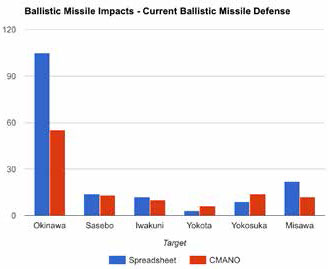
Estimated number of ballistic missile impacts for various U.S. bases with current ballistic missile defenses.
Figure 14
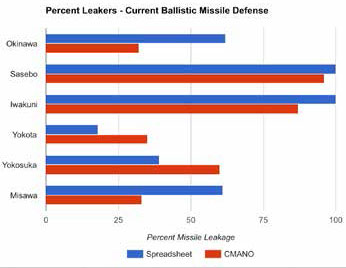
Estimated percent ballistic missile leakage for various U.S. bases with current ballistic missile defenses.
Operational Implications: The Need for Enhanced Deterrent Measures
U.S. and allied efforts are under way to improve defensive areas such as base hardening, force dispersal, and measures to deny, disrupt, or degrade Chinese ISR capabilities, as well as to conduct advanced research into ballistic missile defenses such as high-velocity projectiles, rail guns, and lasers. Along these lines Taiwan is rumored to be planning a request for the vertical takeoff version of the F-35 fighter in its next arms sales request, perhaps understanding that it may have few usable runways in the face of a Chinese missile barrage.47 But the likelihood that a threat of preemptive attack from the PLA Rocket Force already may exist underscores a need to take further action now.
First, the United States should publicly deploy the most robust missile defenses that it can to protect its bases in Japan. In the long term, technological breakthroughs will probably be necessary to pace the growing precision-strike ballistic missile threat at a reasonable cost. But for now, a layered ballistic missile defense is necessary, as the short-range Patriot air and missile defense batteries currently guarding some U.S. and allied bases in Japan seem unlikely to succeed against a mass Chinese raid. Such a robust missile defense would also require deployment of the U.S. Army’s Terminal High Altitude Air Defense (THAAD) system to Japan and/ or tasking Aegis ballistic missile defense destroyers for duty focused on the defense of U.S. bases. (Of note, Japan is now considering purchasing THAAD batteries of its own.)48
To see if such a robust, layered missile defense might help appreciably against the notional missile strike that we constructed, we reran our models and simulations of the strike against a missile defense with the following additions and changes:
two dedicated ballistic missile defense ships armed with significant numbers of SM-3 Block IIA interceptor missiles (a joint U.S./Japan development effort in testing now),49 one U.S. (in the East China Sea) and one Japanese (in the Sea of Japan).
five THAAD batteries (about $1 billion per system)50 in Japan: one on Okinawa, one on Kyushu, one defending the Tokyo area, and conversion to full THAAD batteries of two existing TPY-2 missile defense radar sites on Japan’s west coast.
addition of dedicated Patriot PAC-3 missile batteries to defend U.S. bases at Sasebo and Iwakuni.
modification of Patriot shot doctrine to a one-round-per- missile doctrine that may be more appropriate for mass raids like the one we simulated versus one against smaller numbers of North Korean ballistic missiles.
We found in our revised simulations that, although missile defenses on Okinawa could still likely be overwhelmed by sheer numbers of Chinese SRBMs, the amount of damage would be reduced. More significantly, we found that almost all the ballistic missiles bound for targets in the rest of Japan potentially could be be intercepted, which could at least allow U.S. aircraft to get into the air and mount a defense against cruise missiles, for critical facilities to be evacuated, and for U.S. ships in port to potentially bring up their air defenses and get away from their fixed pier positions.
While some have argued that ballistic missile defense is a hopeless proposition, with interceptors that may cost more than the missiles they are trying to stop, this argument misses one key point: that perhaps the only thing more expensive than layered ballistic missile defense may be not having it in the face of a threat of this magnitude. In this case, an admittedly expensive investment in several billion dollars of missile defense forces seems like it could result in saving tens of billions of dollars of ships, aircraft, and other facilities, as well as the lives of numerous U.S. and allied service members. Perhaps most importantly, it could provide a margin of safety to support firm U.S. action in the face of a crisis, and sow doubt in the minds of the Chinese leadership that such a strike should even be contemplated. It may be just such an assessment on China’s part that is the real force driving vociferous opposition (which on its face otherwise seems illogical) to the recent deployment of THAAD to South Korea.51
In any case, U.S. and allied ballistic missile defense forces will need to publicly practice coordinated defense against mass ballistic missile attacks. Even well-practiced defenders would face a tough challenge in coordinating a real-world defense against a ballistic missile attack of unprecedented scale from a potentially flat-footed stance, with mere minutes to do so and only one chance to get it right.
Given the difficulty and uncertainty associated with defending against a mass missile raid even with robust, layered defenses, U.S. forces and personnel need to practice rapid evacuation of the types of facilities targeted in Rocket Force doctrine. Similarly, key U.S. command centers in Japan should practice rapid execution of continuity-of-operations plans, given that the time available between the first detection of a missile launch by U.S. space-based missile warning sensors to its impact likely will be less than ten minutes.52 In that short amount of time, U.S. early warning centers would have to detect the launched strike, assess it, and warn U.S. forces overseas. Those overseas personnel and command staffs then would need to execute evacuation and continuity procedures in a matter of a few short minutes. Similarly, U.S. ships in port in the Western Pacific would need to be able get away from their pier positions in short order, and high-value air units in the region would need to be able to quickly move their aircraft from their parked positions. In any case, no margin of error will exist for lack of training or proficiency in execution.
To ensure continued deterrence of major power conflict in Asia, as well as continued assurance of regional allies that the United States can intervene effectively if called for, action is necessary to ensure that China cannot gain the upper hand in a conflict through effective missile strikes against U.S. bases. Just as importantly we must ensure that China cannot, through threatening such strikes, put the United States in a position where it is forced to back down in a crisis, irreparably damaging U.S. standing and interests. We must ensure that China is not tempted, as some of the United States’ previous adversaries have been, into making the grave error of trying to knock the United States down, and expecting it not to get back up.
Notes
1. Charles Clover, “China parades ‘carrier-killer’ missile through Beijing,” Financial Times, September 3, 2015, https://www.ft.com/content/b94d907a-507a-11e5-b029-b9d50a74fd14.
2. Javier Hernandez, “China Deploys Aircraft Carrier to Disputed South China Sea,” The New York Times, December 27, 2016, https://www.nytimes.com/2016/12/27/world/asia/south-china-sea-trump.html?_r=0.
3. Dennis J Blasko, “SPECIAL: Sun Tzu Simplified: An Approach to Analyzing China’s Regional Military Strategies,” Asia Eye, April 10, 2015, http://blog.project2049 net/2015/04/special-sun-tzu-simplified-approach-to.html.
4. CLAWS Research Team, “PLA Second Artillery Corps,” Scholar Warrior, Issue 41–42 (spring 2011), 28–29, http://www.claws.in/images/journals_doc/Spring%202011-%20Final%20Issue.41-42.pdf.
5. Michael Chase and Andrew Erickson, “The Conventional Missile Capabilities of China’s Second Artillery Force: Cornerstone of Deterrence and Warfighting,” Asian Security,
8 no.2 (July 2012), 115–137.
6. Ian Easton, “China’s Military Strategy in the Asia-Pacific: Implications for Regional Stability”, Project2049.net, September 26, 2013, http://www.project2049.net/documents/China_Military_Strategy_Easton.pdf.
7. Easton, “China’S Military Strategy.”
8. Kenneth W. Allen and Kevin Pollpeter, editors, Defense Group Inc., “The PLA as Organization v2.0” (paper compilation of a DGI sponsored conference of multiple PLA experts inputs, June 13–14, 2012), http://www.pla-org.com/downloads/.
9. “PLA Rocket Force,” Chinese Defence Today, January 1, 2017, https://sinodefence.com/pla-rocket-force.
10. “20th Air Force Global Strategic Operations and Deterrence Since 1944,” July 20, 2012, http://www.20af.af.mil/About-Us/Fact-Sheets/Display/Article/457703/twentieth-air-force/.
11. “China Takes Bold Steps Toward Military Reform,” Stratfor, January 11, 2016, https://www.stratfor.com/analysis/china-takes-bold-steps-toward-military-reform.
12. Kamphausen, Lai, and Tanner, editors, “Assessing the People’s Liberation Army in the Hu Jintao Era,” Strategic Studies Institute and U.S. Army War College, April 2014, http://ssi.armywarcollege.edu/pdffiles/pub1201.pdf.
13. Sydney J. Freedberg Jr., “China’s Fear Of US May Tempt Them To Preempt: Sinologists,” Breakingdefense.com, October 1, 2013, http://breakingdefense.com/2013/10/chinas-fear-of-us-may-tempt-them-to-preempt-sinologists/2/.
14. Roger Cliff et al., “Entering the Dragon’s Lair: Chinese Antiaccess Strategies and Their Implications for the United States,” RAND, 2007, http://www.rand.org/content/dam/rand/pubs/monographs/2007/RAND_MG524.pdf.
15. Dean Cheng, “China’s Newest Defense White Paper Suggests Fundamental Change in Perspective,” July 6, 2015, http://www.heritage.org/defense/report/chinas-newest-defense-white-paper-suggests-fundamental-change-perspective.
16. Milan N. Vego, Soviet Naval Tactics (Annapolis: Naval Institute Press, 1992), 173.
17. Robert Waring Herrick, Soviet Naval Doctrine and Policy, Vol. 3: 1956–1986, Studies in Russian History, Book 8 (Edwin Mellen, July 2003), 983.
18. D. C. Kephart and M. J. Parise, “Damage Probabilities for Small-CEP, Low-Yield, Airburst/Groundburst Attacks Against Selected PVN and QVN Point Targets,” Report No. R-1820-PR, RAND, August 1975, https://www.rand.org/content/dam/rand/pubs/ reports/2005/R1820.pdf.
19. Easton, “China’S Military Strategy.”
20. John R. Lindsay, “The Impact of China on Cybersecurity: Fiction and Friction,” International Security 39 no. 3, (Winter 2014/15), http://www.belfercenter.org/sites/default/files/files/publication/IS3903_pp007-047.pdf.
21. Eric Heginbotham et al., “The U.S.-China Military Scorecard Forces, Geography, and the Evolving Balance of Power, 1996–2017,” RAND, 2015, http://www.rand.org/content/dam/rand/pubs/research_reports/RR300/RR392/RAND_RR392.pdf; and U.S. Department of Defense, Annual Report to Congress: Military and Security Developments Involving the People’s Republic of China 2017 (Washington, DC, 2017), 57.
22. Roger Cliff et al., “Shaking the Heavens and Splitting the Earth: Chinese Air Force Employment Concepts in the 21st Century,” Report UG635.C6S53, RAND, 2011, 48, http://www.rand.org/content/dam/rand/pubs/monographs/2011/ RAND_MG915.pdf; and David Hambling, “After Cluster Bombs: Raining Nails,”wired.com, May 30, 2009, https://www.wired.com/2008/05/after-cluster-b/.
23. John P. Rafferty, “Hard-target munition,” March 10, 2014, https://www.britannica.com/technology/hard-target-munition.
24. Sean O’Connor, “PLA Second Artillery Corps,” Report APA-TR-2009-1204, AUS AIR POWER, December 2019), http://www.ausairpower.net/APA-PLA-Second-Artillery-Corps.html; Google Maps location, https://www.google.com/maps/@40.4488911,93.5490708,11902m/data=!3m1!1e3.
25. Andrew S. Erickson, “Showtime: China Reveals Two ‘Carrier-Killer’ Missiles,” Nationalinterest.org, September 3, 2015, http://nationalinterest.org/feature/showtime-china-reveals-two-carrier-killer-missiles-13769.
26. “China’s V-Day military parade in Beijing 2015,” YouTube, September 3, 2015, https://www.youtube.com/watch?v=YoC0Xcjko0A&sns=em.
27. “2016 Rocket Force Major Exercises,” YouTube, January 15, 2017, https://www.youtube.com/watch?v=ML_0sGIUdqs&feature=youtu.be.
28. Toshi Yoshihara, “Chinese Missile Strategy and the U.S. Naval Presence in Japan The Operational View from Beijing,” Naval War College Review, 63 no. 3 (Summer 201), 39–62, https://www.usnwc.edu/getattachment/69198ee2-edc2-4b82-8f85-568f80466483/Chinese-Missile-Strategyand-the-U-S--Naval-Presen.
29. Toshi Yoshihara, “How Vulnerable are U.S. bases in the Pacific now?” Globalpublicsquare.blogs.cnn.com, December 7, 2012, http://globalpublicsquare.blogs.cnn.com/2012/12/07/u-s-bases-in-japan-sitting-ducks/.
30. Kamphausen et al., “Assessing the People’s Liberation,” 316.
31. Eric Heginbotham et al., “The U.S.-China Military Scorecard Forces, Geography, and the Evolving Balance of Power, 1996–2017.”
32. “U.S. Navy air wing’s move from Atsugi to Iwakuni decided,” The Asahi Shimbun, January 6, 2017, http://www.asahi.com/ajw/ articles/AJ201701060056.html.
33. Eric Heginbotham et al., “The U.S.-China Military Scorecard Forces, Geography, and the Evolving Balance of Power, 1996–2017,” 28.
34. Bill Gertz, “China Flight-Tests 10 DF-21 Missiles: Show of force comes amid transition to Trump,” Washington Free Beacon, December 2, 2016. http://freebeacon.com/national-security/china-flight-tests-10-df-21-missiles/; and “CCTV – China 10 DF-21C Ballistic Missiles Salvo Launch [1080p],” Youtube, January 17, 2017, https://www.youtube.com/watch?v=0Ts8Hmse7Ms&index-=2&list=PLIROWBpahw4BZhTt0jV5QTKkYBBQfoNQ3.
35. Michael Elleman and Michael J. Zagurek Jr., “THAAD: What It Can and Can’t Do,” March 10, 2016, http://38north.org/2016/ 03/thaad031016/.
36. “Patriot Advanced Capability-3 (PAC-3),” http://www.dote.osd.mil/pub/reports/FY2012/pdf/army/2012patriot.pdf.
37. Stephen D. Weiner and Sol M. Rocklin, “Discrimination Performance Requirements for Ballistic Missile Defense,” The Lincoln Laboratory Journal, 7 no. 1 (1994), http://www.ll.mit.edu/publications/journal/pdf/vol07_no1/7.1.3.discriminationperformance.pdf.
38. “AN/MPQ-53 multifunction phased-array radar Patriot MIM-104,” December 12, 2010, http://www.armyrecognition.com/ patriot_mim-104_vehicles_systems_us_army_uk/an/mpq-53_patriot_radar_search_detection_illumination_data _sheet_specifications_information_uk.html.
39. “THAAD Radar Ranges,” July 17, 2016, https://mostlymissiledefense.com/2016/07/17/thaad-radar-ranges-july-17-2018/.
40. George Lewis and Theodore Postol, “Ballistic Missile Defense: Radar Range Calculations for the AN/TPY-2 X-Band and NAS Proposed GBX Radars,” September 21, 2012, https://mostlymissiledefense.com/2012/09/21/ballistic-missile-defense-radar-range-calculations-forthe-antpy-2-x-band-and-nas-proposed-gbx-radars-september-21-2012/.
41. Commercially available simulation, “Command: Modern Air/Naval Operations,” September 2013, http://www.warfaresims.com/?page_id=1101.
42. “Command Professional Edition,” Warfare Sims, retrieved 17 May 2017, www.warfaresims.com/?page_id=3822.
43. Craig Richard, “From Epsom to the Pentagon: Surrey game makers The Slitherine Group brief US military chiefs in Virginia,” Your Local Guardian, May 17, 2017. www.yourlocalguardian.co.uk/news/14746038.From_Epsom_to_the_Pentagon__Surrey_game_makers_brief_US_military_chiefs_in_Virginia/.
44. “South Korea’ Lotte approves land swap for missile defence: ministry,” Reuters, February 27, 2017, http://www.reuters.com/article/us-southkorea-usa-thaad-lotteidUSKBN1660P6.
45. “PLA Rocket Force,” https://sinodefence.com/pla-rocketforce.
46. Joe Pappalardo, “Behind the Scenes at a Rehearsal For Armageddon,” Popular Mechanics, July 28, 2014, http://www.popularmechanics.com/ military/a9936/behindthe-scenes-at-a-rehearsal-for-armageddon-16355867/.
47. Samson Ellis, Adela Lin, and Ting Shi, “Taiwan’s Pursuit of F-35 Tests Trump’s Early Rapport With Xi” Bloomberg.com, April 26, 2017, https://www.bloomberg.com/politics/articles/2017-04-26/taiwan-s-pursuit-of-f-35s-teststrump-s-early-rapport-with-xi.
48. “Japan to upgrade Patriot batteries for Olympics as N. Korean missile threat grows-sources,” July 28, 2016, http://news.trust.org/item/20160728230129-f3on1/.
49. Megan Eckstein, “New SM-3 Block IIA Intercepts Ballistic Missile in Space For First Time,” USNI News, February 6, 2017, https://news.usni.org/2017/02/06/standard-missile-3-block-iia-intercepts-target-in-space-for-first-time.
50. J. Weston Phippen, “Actually, the U.S. Will Pay for the THAAD Anti-Missile System,” The Atlantic, April 2017, https://www.theatlantic.com/ news/archive/2017/04/uspay-south-korea-thaad-missile/524880/.
51. “Why China is wrong to be furious about THAAD,” Economist.com, May 23, 2017, http://www.economist.com/news/asia/21719485-deployment-american-anti-missile-system-south-korea-does-not-threaten-chinas-nuclear.
52. “Space Based Infrared System,” af.mil, November 23, 2015, http://www.af.mil/About-Us/Fact-Sheets/Display/Article/104549/space-based-infrared-system/.
About the Authors
Commander Thomas Shugart (US Navy) is a Navy Federal Executive Fellow at the Center for New American Security (CNAS). He is also a submarine warfare officer, and most recently commanded the USS Olympia (SSN-717).
Commander Javier Gonzalez (US Navy) is a Navy Federal Executive Fellow at the Johns Hopkins University Applied Physics Laboratory. He is also a surface warfare officer, and most recently commanded the USS Momsen (DDG-92).
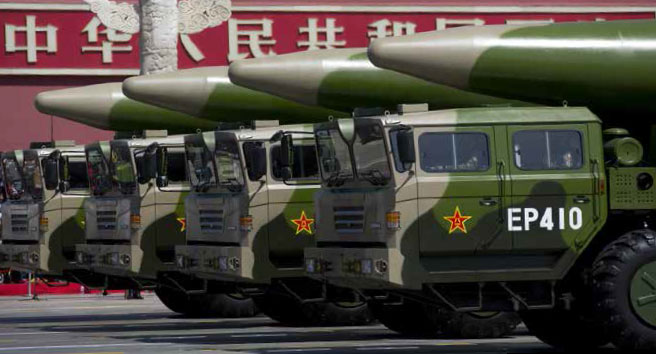
No comments:
Post a Comment